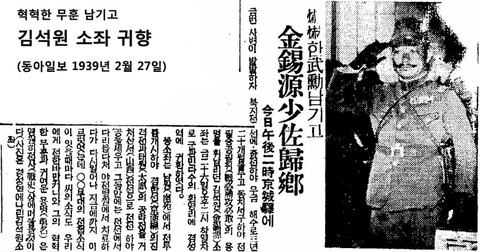Name Kim Suk-won | ||
 | ||
Born 29 September 1893Seoul, Korea ( 1893-09-29 ) Years of service 1925–19451945–1950, 1952–1956 Battles and wars | ||
Kim Suk-won (29 September 1893 – 6 August 1978) was a major general in the Imperial Japanese Army during World War II. He was the third-highest ranking ethnic Korean in the Japanese Army behind Lt. General Hong Sa-ik and Korean Crown Prince Euimin.
Contents
Biography

Born in Seoul, Kim was sent to Japan for studies in 1909 just before the Empire of Korea was annexed by Japan.
Kim entered the 27th class of the Imperial Japanese Army Academy in 1913. At that time, there were several students from Korea enrolled at the military academy. Many of those who opposed the annexation had already left to join in the movements for Korean independence; others followed the advice of Ji Cheong-cheon, who argued that they should stay and learn military skills from the Japanese before joining the independence movements. However, Kim saw the annexation of Korea as an opportunity for advancement, and a chance to prove his loyalty to Japan. Following his 1915 graduation, Kim was assigned to the IJA 4th Division, based in Osaka. In 1917, Kim was promoted to the rank of first lieutenant.
Invasion of Manchuria
During the 1931 invasion of Manchuria, Kim was captain of a mechanised artillery division, which had a distinguished combat record. After the 1937 outbreak of the Second Sino-Japanese War, Kim was further promoted to major, and assigned to the IJA 20th Division based outside of Seoul, which was a singular indication of the trust that he had attained within the Japanese military. In May 1937, Kim led the 74th Infantry Regiment (based in Hamhung and commanded by Kim Ik Uk) on a mission to eradicate Kim Il Sung's bandits in the border area around Baekdu Mountain. However, his force of about 2,000 men walked into a trap set by Kim Il Sung at Chiensan Pass, some distance north of Hyesanjin and Kim Il Sung's ten heavy machine guns mowed down Kim Suk Won's Japanese troops. Kim escaped the encounter with only 200 survivors.
Second Sino-Japanese War
Kim was dispatched to mainland China in July 1937. Prior to departing, he announced that he intended to die for the Emperor in battle and asked that a school be established in his memory, to be financed partly by the 700 won reward money he had received from Emperor Hirohito for his previous victories in Manchuria. However, this request alarmed the officials in the Japanese administration in Korea, who felt that such a school in honor of an ethnic Korean that might foster Korean nationalism.
Kim distinguished himself again at the Battle of Dingwon on 28 July 1937, where he led two companies of Japanese soldiers in a seven-hour hand-to-hand combat that smashed a Chinese division. He was awarded several medals and the Governor-General of Korea gave his permission for a school, the "Won Suk Academy" to be founded in 1938. This academy is known today as Seongnam Junior and Senior High Schools.
Following the 1939 implementation of the sōshi-kaimei (name change) policy, Kim adopted the Japanese style name Kaneyama Shakugen, by adding the character for "mountain" to his Korean surname Kim; his Japanese given name "Shakugen" was just the Japanese reading of his Korean name.
Kim was promoted to lieutenant colonel soon after the Dingwon battle, reassigned to the 78th Infantry Regiment of the IJA 20th Division, located in Yongsan.
In 1943, Kim was further promoted to major general; he was active on the home front in Korea during this time, giving speeches at schools and publishing articles in the official newspaper Maeil Sinbo encouraging Korean youths to volunteer to serve in the Imperial Japanese Army. He was also instrumental in the implementation of the draft on the Korean peninsula, which began from January 20, 1944.
After World War II
After the surrender of Japan ended World War II, Kim joined the Provisional Government of the Republic of Korea's military affairs commission, and later the Republic of Korea Army, where he held the rank of brigadier general. In 1948, Korean President Syngman Rhee put Kim in charge of the South Korean border units, and attempted to name him commander of the South Korean Army, but was overridden by General Walton H. Walker of the United States Eighth Army, who distrusted Kim's background.
Kim retired from active duty, but was recalled in early July 1950 due to the outbreak of the Korean War. He published his memoirs in 1977. He retired again in 1956. After his death in 1978, he was buried next to Seongnam High School, of which he was one of the founders. A bronze bust of him remains standing on the school ground; in 2002, protestors attempted to have it taken down.
